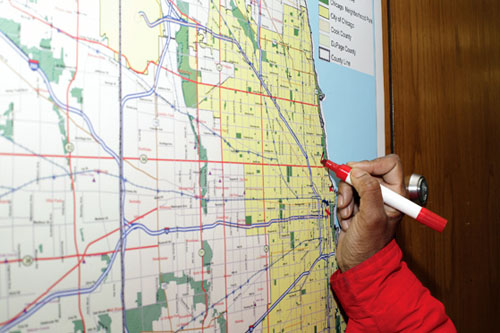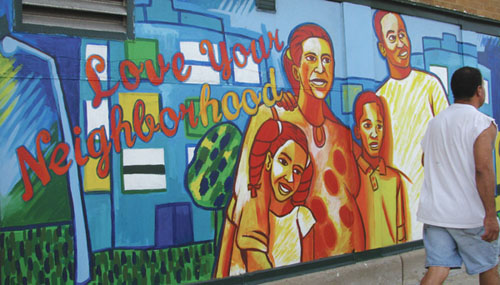What's your favorite place in your neighborhood? Chances are it's a place where your neighbors meet, children play, and friends share benches and coffee; where there are always things to do and people to see. It's a place where you always feel comfortable, happy and safe.
In a city-wide campaign to generate even more of these vibrant places in Chicago's neighborhoods, the Metropolitan Planning Council of Chicago (MPC) recently has paired up with New York City's Project for Public Spaces (PPS), an internationally recognized expert in community-based public space planning. To launch this project, leaders from Chicago's communities and public agencies converged at the King Center on Chicago's South Side in October to participate in two, day-long interactive workshops to learn "placemaking" techniques.
Placemaking is a strategy for "making places around the way people want to use them," explains Karin Sommer, MPC placemaking project manager. It's a "deceptively simple" approach, according to Fred Kent, president and founder of Project for Public Spaces. It starts with identifying what it is about a place that seems to generate comfort, peace and happiness. Then, it's about seeking out the highest and best use for that space and, working together as a neighborhood and with city agencies, making it happen.
Placemaking is a subtle but profound shift in the way we commonly think about planning and design, primarily because it inverts traditional "top-down" design mechanisms. "You have to begin by asking what people want to do in a space, and then ask how you can support that with design. The community is the expert," says Ethan Kent, vice president of PPS and Fred's son.
In other words, you don't design a place, explains Fred. "You grow a place."
The goal of these workshops and MPC's larger Chicago placemaking campaign is to "institutionalize this very organic approach, and make sure that these placemaking strategies operate de facto in communities and existing citywide planning processes," says Peter Skosey, MPC vice president of external relations.
Sharing the concept with Chicago's community and public sector leaders at the October workshops was the first step in making placemaking "standard operating procedure" from Roseland to Rogers Park. "The workshops mark the start of our effort to work with Project for Public Spaces to bring placemaking to Chicago on a large scale. This is phase one of a multi-year process," says Skosey.
Each workshop was tailored to meet the unique needs of the participants. The first session was geared toward Chicago's community group leaders, active residents, and Special Service Area (SSA) administrators. It centered on strategies for building consensus and seeking the outside (and sometimes unlikely) partnerships that make placemaking possible.

In the second group were representatives from Chicago's public sector, including staff from the Chicago Park District, Chicago Dept. of Transportation, Chicago Metropolitan Agency for Planning, Chicago aldermanic offices, and other agencies. Addressing this group, Ethan Kent said, "Your job is to inform community leaders and facilitate the placemaking process" - but not necessarily to direct it.
Both days began with presentations from senior PPS staff, including Renee Espiau, Fred and Ethan. Their talks introduced the 11 foundational principles of placemaking, using photographs of great places around the world to illustrate their points. Workshop participants interrupted regularly to discuss how these ideas would work in Chicago.
The afternoon sessions centered on the "Place Game:" attendees broke into small groups led by PPS staff and evaluated places along 43rd Street to practice assessing public space challenges - the first phase in PPS's "step-by-step guide" to implementing placemaking improvements.
At the end of the first day, community participants drafted a list of "obstacles" to collaboration with city agencies, which was then presented to public sector representatives on the second day.
Each participant arrived with a unique perspective and placemaking prospects. All seemed to leave enlivened and inspired with ways they could initiate placemaking strategies in their neighborhoods or agencies.
Sam Strain from Ald. Bob Fioretti's office attended the second workshop. He said the techniques he learned from this workshop will be applied to the 2nd Ward's massive undertaking to double the number of their public spaces over the next year-and-a-half. "Just in the past hour, listening to Fred and Ethan, I've gained more ideas about how to go about this project than ever before," said Strain. "I hope to start the community process based off models I'm learning right now."
For Joyce Fernandes, executive director of Architreasures, who attended the first workshop for community leaders, the day was a way to "find approaches to access existing resources within city agencies, within the CTA, within CDOT..." Sara Morton also came to the first workshop. She represented O-H Community Partners and said the workshop helped her think of concrete strategies for small, inexpensive steps she could take toward making a great place in her neighborhood.
Anna Barnes is an active resident of Logan Square and the coordinator of the El Yunque Community Garden. She says the placemaking workshop helped her envision a "kind of corridor between my garden and a nearby one" that would unite two great places within her community. She came to "find out about partnerships and funding and the community planning process" in order to move her ideas forward. The workshop gave her a way to think of the garden as a place to generate community. She hopes through placemaking, it will become a destination where residents who have made a home there for decades can mix with new arrivals to the neighborhood.

Kate Miller found the workshop useful for similar reasons. She came to the conference as a representative of the 61st Street Farmer's Market and wanted to learn to use placemaking strategies for encouraging stakeholder involvement, "to activate the market as a bridge among communities, between Hyde Park and Woodlawn, South Shore, and Washington Park."
Gina Caruso, who attended the conference from the Chicago Dept. of Planning and Development, said that the biggest thing she took away from this workshop is a fresh perspective. After PPS' presentations, she realized she needs to "ease back" in community meetings and concentrate first "not on funding or liability or loss, but on what we want in the community."
Pete Korzynski and Nick Kollias attended the first workshop from the Greater Southwest Chicago Development Corporation. As directors of this SSA, they are now engaged in a project of large-scale commercial revitalization. They want to transform vacant lots and empty storefronts into active, well-used places in their neighborhood. They came to the workshop to gather strategies for enacting placemaking principles in a low-income area of Chicago. For Korzynski, the conference was also "a way to connect to other SSA directors and see what they are doing," a way to speed up the placemaking process and get ideas about how to carry it through to completion.
During every short break, the room came alive when participants leaned over their chairs to talk quickly to their neighbors, sharing coffee, business cards and email addresses. Building connections like the kind Korzynski established to create an active network of "Placemakers" was important to both groups. At the workshop, Ethan Kent urged participants to consider "how we can start a broader coalition, a broader conversation. We have to do organizing at all scales. You are all engaged in doing pieces of this project but you need each other to make a larger change."
The networking that began at the conference will be continued on the website, PlacemakingChicago.com, where participants ultimately will be able to log their placemaking struggles and successes and connect with others to share ideas and stories. Visitors to the site also can read local stories of placemaking in action and download a free copy of "A Guide to Neighborhood placemaking in Chicago," a joint publication between MPC and PPS distributed to all participants.
"The workshop and the guidebook are meant to empower people in the community to come to consensus and undertake placemaking work themselves," says Cheri Heramb, MPC's placemaking Project chair.
Ethan Kent says these workshops and the larger placemaking campaign in Chicago are going to "create settings to change relationships that can generate placemaking processes throughout the city. This project is not just an alliance between MPC and PPS. It's about all of us together, working to make the city better."





